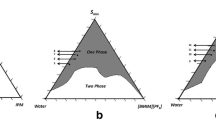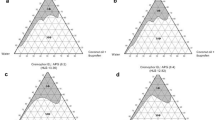Abstract
In this research work, a new biocompatible microemulsion containing castor oil has been formulated to increase the solubility of celecoxib, as a well-known anti-inflammatory drug. In this formulation castor oil has also anti-inflammatory properties. The proposed oil-in-water microemulsion composed of Tween 80 as surfactant, isobutanol as co-surfactant, and castor oil as the oil phase. In the first step, the phase diagrams of the proposed colloid systems with surfactant to co-surfactant mass ratios of 4 : 1 and 2 : 1 were prepared at ambient temperature. Then, using the obtained phase diagrams, the appropriate formulations were selected by combining different percentages of water, oil, surfactant and co-surfactant in the microemulsion region. Some of physico-chemical properties, such as electrical conductivity, density, refractive index, surface tension and particle size of the selected microemulsion formulations have been determined at 298 K. After that, the solubility of celecoxib in the selected formulations was determined and compared with other reported microemulsion formulations. Interesting results from this section indicated that the solubility of celecoxib significantly increased compared to pure water and the previous proposed formulations. The results of this study can be used to provide suitable formulations based on the biocompatible microemulsions for celecoxib in pharmaceutical industry.





Similar content being viewed by others
REFERENCES
Liu, X., Zhao, L., Wu, B., and Chen, F., Improving solubility of poorly water-soluble drugs by protein-based strategy: A review, Int. J. Pharm., 2023, vol. 635, p. 122704. https://doi.org/10.1016/j.ijpharm.2023.122704
Lawrence, M.J. and Rees, G.D., Microemulsion-based media as novel drug delivery systems, Adv. Drug Delivery Rev., 2000, vol. 45, no.1, pp. 89–121. https://doi.org/10.1016/s0169-409x(00)00103-4
Souto, E.B., Cano, A., Martins-Gomes, C., Coutinho, T.E., Zielińska, A., and Silva, A.M., Microemulsions and nanoemulsions in skin drug delivery, Bioengineering, 2022, vol. 9, no. 4, p. 158. https://doi.org/10.3390/bioengineering9040158
Eastoe, J., Microemulsions, in Colloid Science: Principles, Methods and Applications, Cosgrove, T., Ed., Wiley, 2005, 1st ed., pp. 48–84.
Kale, S.N. and Deore, S.L., Emulsion, micro emulsion and nano emulsion: A review, Syst. Rev. Pharm., 2017, vol. 8, no. 1, pp. 39–47. https://doi.org/10.5530/srp.2017.1.8
McClements, D.J., Nanoemulsions versus microemulsions: Terminology, differences, and similarities, Soft Matter, 2012, vol. 8, no. 6, pp. 1719–1729. https://doi.org/10.1039/C2SM06903B
Moniruzzaman, M., Tahara, Y., Tamura, M., Kamiya, N., and Goto, M., Ionic liquid assisted transdermal delivery of sparingly soluble drugs, Chem. Commun., 2010, vol. 47, no. 9, pp. 1452–1454. https://doi.org/10.1039/B907462G
Hejazifar, M., Lanaridi, O., and Schroder, K.B., Ionic liquid based microemulsions: A review, J. Mol. Liq., 2020, vol. 303, no. 4, p. 112264. https://doi.org/10.1016/j.molliq.2019.112264
Sharma, H., Kumar Sahu, G., and Kaur, C.D., Development of ionic liquid microemulsion for transdermal delivery of a chemotherapeutic agent, SN Appl. Sci., 2021, vol. 3, no. 2, p. 215. https://doi.org/10.1007/s42452-021-04235-x
Parsi, E. and Salabat, A., Comparison of O/W and IL/W microemulsion systems as potential carriers of sparingly soluble celecoxib drug, J. Solution Chem., 2020, vol. 49, no. 1, pp. 68–82. https://doi.org/10.1007/s10953-019-00940-9
Salabat, A., Ionic liquid assisted microemulsions for drug delivery, in Application of Ionic Liquids in Drug Delivery, Goto, M. and Munirozzaman, M., Eds., Springer, 2021, 1st ed., pp. 219–242.
Krickl, S., Jurko, L., Wolos, K., Touraud, D., and Kunz, W., Surfactant-free microemulsions with cleavable constituents, J. Mol. Liq., 2018, vol. 271, pp. 112–117. https://doi.org/10.1016/j.molliq.2018.08.120
Zhang, X., Song, M., Chai, J., Cui, X., and Wang, J., Preparation, characterization and application of a surfactant-free microemulsion containing 1-octen-3-ol, ethanol, and water, J. Mol. Liq., 2020, vol. 300, p. 112278. https://doi.org/10.1016/j.molliq.2019.112278
Mirhoseini, B.S. and Salabat, A., A novel surfactant-free microemulsion system for the synthesis of poly(methyl methacrylate)/Ag nanocomposite, J. Mol. Liq., 2021, vol. 342, p. 117555. https://doi.org/10.1016/j.molliq.2021.117555
Ali, M.K., Moshikur, R.M., Wakabayashi, R., Tahara, Y., Moniruzzaman, M., Kamiya, N., and Goto, M., Synthesis and characterization of choline-fatty-acid-based ionic liquids: A new biocompatible surfactant, J. Colloid Interface Sci., 2019, vol. 551, pp. 72–80. https://doi.org/10.1016/j.jcis.2019.04.095
Ali, M.K., Moshikur, R.M., Wakabayashi, R., Moniruzzaman, M., Kamiya, N., and Goto, M., Biocompatible ionic liquid surfactant-based microemulsion as a potential carrier for sparingly soluble drugs, ACS Sustainable Chem. Eng., 2020, vol. 8, no. 16, pp. 6263–6272. https://doi.org/10.1021/acssuschemeng.9b07773
Saleem, M.A., Nazar, M.F., Siddique, M.Y., Khan, A.M., Ashfaq, M., Hussain, S.Z., Khalid, M.R., and Yameen, B., Soft-templated fabrication of antihypertensive nano-Irbesartan: Structural and dissolution evaluation, J. Mol. Liq., 2019, vol. 292, p. 111388. https://doi.org/10.1016/j.molliq.2019.111388
Callender, S.P., Mathews, J.A., Kobernyk, K., and Wettig, S.D., Microemulsion utility in pharmaceuticals: Implications for multi-drug delivery, Int. J. Pharm., 2017, vol. 526, no. 2, pp. 425–442. https://doi.org/10.1016/j.ijpharm.2017.05.005
Kajbafvala, A. and Salabat, A., A novel one-step microemulsion method for preparation of quercetin encapsulated poly(methyl methacrylate) nanoparticles, Iran. Polym. J., 2017, vol. 26, no. 7, pp. 651–662. https://doi.org/10.1007/s13726-017-0550-0
Kajbafvala, A., Salabat, A., and Salimi, A., Formulation, characterization and in-vitro/ex-vivo evaluation of quercetin-loaded microemulsion for topical application, Pharm. Dev. Technol., 2018, vol. 23, no. 8, pp. 741–750. https://doi.org/10.1080/10837450.2016.1263995
Salabat, A. and Parsi, E., Ex vivo evaluation of celecoxib release from ionic liquid-based microemulsions and microemulgels for topical applications, J. Iran. Chem. Soc., 2021, vol. 18, no. 6, pp. 1355–1361. https://doi.org/10.1007/s13738-020-02122-7
Kajbafvala, A. and Salabat, A., Microemulsion and microemulsion gel formulation for transdermal delivery of rutin: Optimization, in-vitro/ex-vivo evaluation and SPF determination, J. Dispersion Sci. Technol., 2022, vol. 43, no. 12, pp. 1848–1857. https://doi.org/10.1080/01932691.2021.1880928
Gharbavi, M., Sharafi, A., Motamed Fath, P., Oruji, S., Pakzad, H., and Kheiri Manjili, H., Formulation and biocompatibility of microemulsion-based PMBN as an efficient system for paclitaxel delivery, J. Appl. Biotechnol. Rep., 2021, vol. 8, no. 1, pp. 51–62. https://doi.org/10.30491/jabr.2020.114985
Rahman, H.M.A.U., Afzal, S., Nazar, M.F., Alvi, D.A., Khan, A.M., and Asghar, M.N., Phase behavior of a TX-100/oleic acid/water based ternary system: A microstructure study, J. Mol. Liq., 2017, vol. 230, pp. 15–19. https://doi.org/10.1016/j.molliq.2017.01.011
Funding
This work was supported by ongoing institutional funding. No additional grants to carry out or direct this particular research were obtained.
Author information
Authors and Affiliations
Corresponding author
Ethics declarations
The authors of this work declare that they have no conflicts of interest.
Additional information
Publisher’s Note.
Pleiades Publishing remains neutral with regard to jurisdictional claims in published maps and institutional affiliations.
Rights and permissions
About this article
Cite this article
Alireza Salabat, Nesa Ghorbani Development of a New Biocompatible Colloid System to Improve the Solubility of Celecoxib. Colloid J 86, 323–329 (2024). https://doi.org/10.1134/S1061933X23601270
Received:
Revised:
Accepted:
Published:
Issue Date:
DOI: https://doi.org/10.1134/S1061933X23601270




